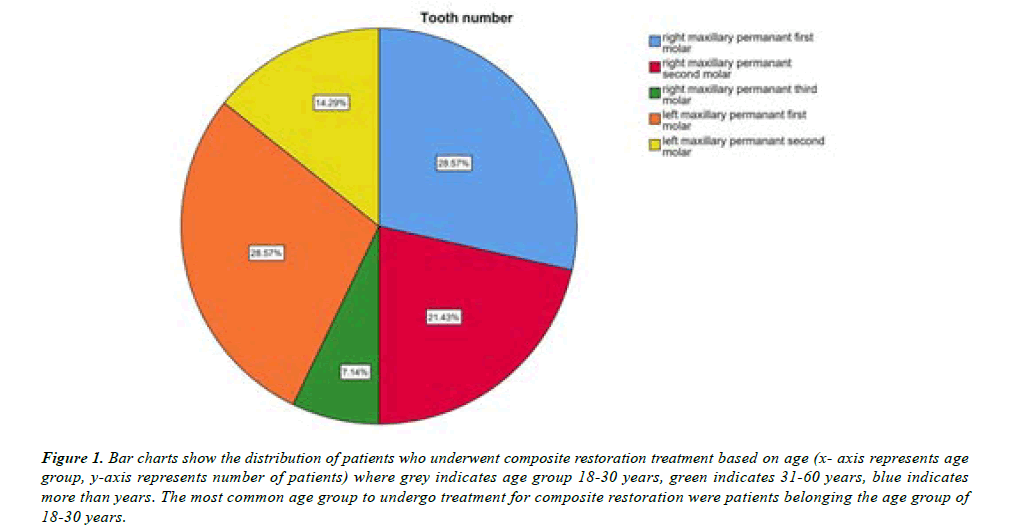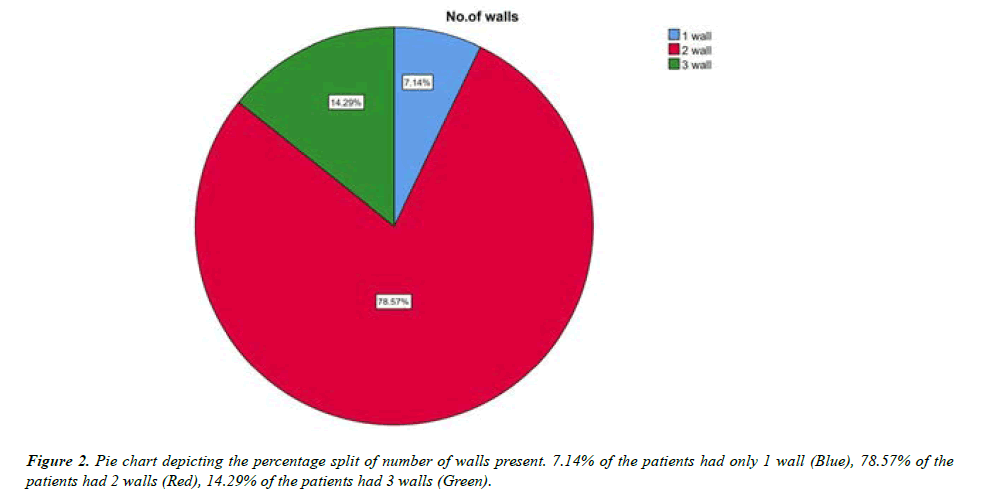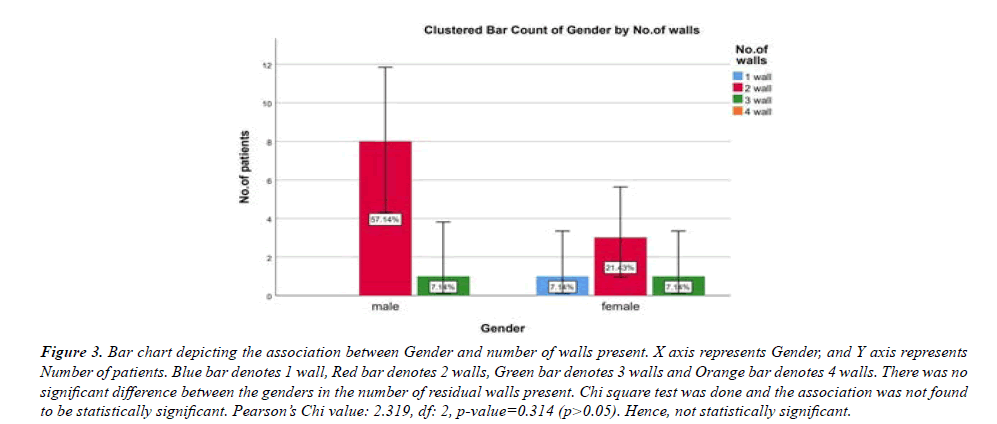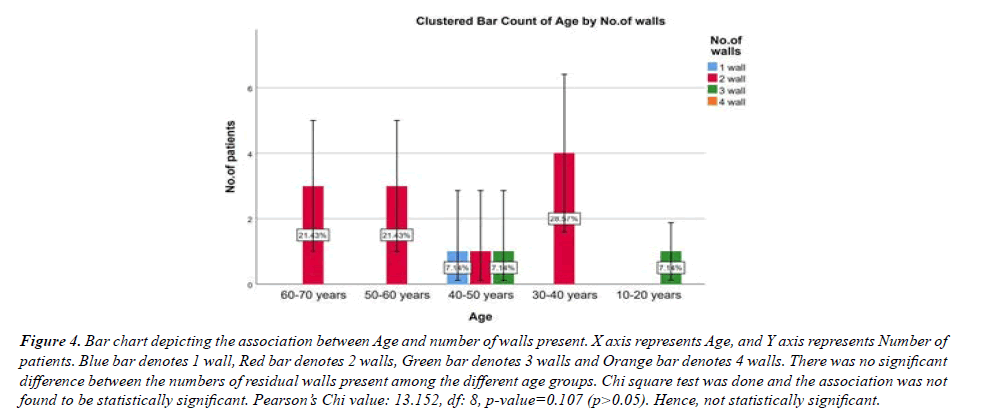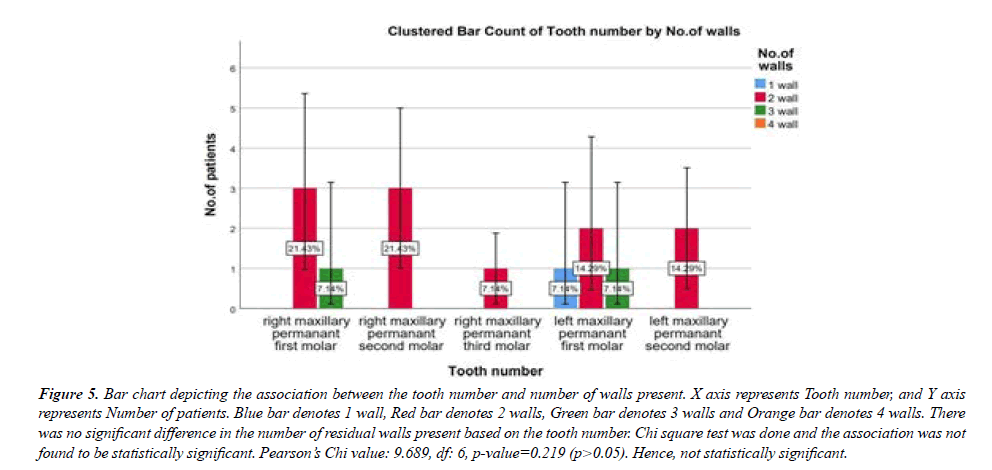Research Article - Journal of Clinical Dentistry and Oral Health (2023) Volume 7, Issue 1
Evaluating the Number of Walls Present and Its Significance on the Teeth Restored with Prefabricated Fibre Post in Maxillary Molars
Bala S and Sugumaran S*
Department of Conservative Dentistry and Endodontics, Saveetha Dental College, Saveetha Institute of Medical and Technical Sciences, Saveetha University, Chennai, India
- Corresponding Author:
- Sugumaran S
Department of Conservative Dentistry and Endodontics
Saveetha Dental College, Saveetha Institute of Medical and Technical Sciences
Saveetha University, Chennai, India
E mail: surendars.sdc@saveetha.com
Received: 19-Dec-2022, Manuscript No. AACDOH-22-84208; Editor assigned: 20-Dec-2022, PreQC No. AACDOH-22-84208 (PQ); Reviewed: 04-Jan-2023, QC No. AACDOH-22-84208 (QC); Revised: 09-Jan-2023, Manuscript No. AACDOH-22-84208 (R); Published: 16-Jan-2023, DOI: 10.35841/aacdoh-7.1.135
Citation: Sathiyamoorthy S, Sugumaran S. Evaluating the number of walls present and its significance on the teeth restored with prefabricated fibre post in maxillary molars. J Clinic Dent Oral Health. 2023;7(1):135
Abstract
Introduction: Endodontic ultimate goal is to keep a tooth alive for as long as feasible for the patient. Posts, whether prefabricated metal posts, cast posts, or fibre posts, are used to restore many teeth. Although fibre posts are currently the greatest alternative, prefabricated metal posts have proven to be the most popular. Depending on how each circumstance presents it, the various solutions provide additional flexibility. Posts can help strengthen the relationship between the coronal building material and the remaining tooth structure by retaining amalgam, metal, and composite cores. The aim of the study is to evaluate the number of walls present and its significance on the teeth restored with prefabricated fibre posts in maxillary molars. Materials and method: In this retrospective study, the data was collected from the hospital database and further analysis was done and the results were tabulated. A statistical analysis of the collected data regarding the variance among the different number of residual walls seen in maxillary molars undergoing prefabricated fiber post treatment. Results: The study sample consisted of 14 patients who underwent prefabricated fibre posts treatment in maxillary molars. 28.57% were performed in right maxillary permanent first molar, 21.43% were performed in right maxillary permanent second molar, 7.14% were performed in right maxillary permanent third molar, 28.57% were performed in left maxillary permanent first molar, and 14.29% were performed in left maxillary permanent second molar. 7.14% of the patients had only 1 wall, 78.57% of the patients had 2 walls and 14.29% of the patients had 3 walls. The association between the tooth number and number of walls present was not found to be statistically significant (p value= 0.219). Discussion: In the present study, 2 walls based prefabricated fibre posts were more prevalent. It can be inferred that prefabricated fibre posts are more commonly indicated in maxillary molars with some solid amount of vital tooth structure. Previous studies have not correlated the significance between number of walls present and the use of prefabricated fibre posts in maxillary molars. Previous study conducted by Nam et al had concluded that in terms of fracture resistance and stress distribution, the FRC post was beneficial in lower premolars, especially with two or more walls. Conclusion: Within the limitations of the study, it can be concluded the remaining coronal walls influence the type of post selected for the restoring endodontically treated teeth. The prevalence of prefabricated fiber posts in maxillary molars was most commonly seen in teeth with 2 residual walls. Fiber reinforced posts are the most preferred post in posterior teeth, due to its flexural strength matching the dentin and its better distribution of stress among the remaining tooth structure.
Keywords
Prefabricated fibre posts, RCT, Maxillary molars, Innovative technology, Residual walls.
Introduction
Endodontics' ultimate goal is to keep a tooth alive for as long as feasible for the patient. Posts, whether prefabricated metal posts, cast posts, or fibre posts, are used to restore many teeth. Although fibre posts are currently the greatest alternative, prefabricated metal posts have proven to be the most popular [1]. It's easier to use, less expensive, and offers greater variety clinicians can get a variety of sizes. Depending on how each circumstance presents itself, the various solutions provide additional flexibility [2]. The objective of a post in endodontic restoration is to keep the core in place. Posts can help strengthen the relationship between the coronal building material and the remaining tooth structure by retaining amalgam, metal, and composite cores [3]. In order to put an effective post and core, some variables must be addressed. These criteria can serve as guidelines for the physician, such as the quantity of tooth structure, the quality of tooth structure, the existence of neighboring dental structures, occlusal considerations, and the necessity for future restoration [4]. Clinicians will be able to make the best option based on the case at hand if they understand how these elements influence restorative principles. Quantity of tooth structure: In terms of quantity, a doctor should consider putting a post when more than half of a tooth's structure is absent. The question is whether there is adequate structure to keep the crown in place. It is determined by the ferrule, which is a 360° crown collar that surrounds the parallel walls of the dentine and continues coronally to the preparation's shoulder. The physician may encounter situations where there is no ferrule or where the ferrule is nearly perfect [5]. Although there are exceptions, the ideal situation is when there is no need for a core and the natural tooth serves as the core. When recovering a tooth, it's best to have 3 mm of wall on one side and 2 mm on the other, implying a ferrule of at least 2 mm. The clinician will have a better likelihood of success if these parameters are met. Restorations can happen in other circumstances, but the patient should be advised that failure is a possibility in some cases [6]. Quality of tooth structure: The physician is looking for signs of non-ideal circumstances such as discolouration, cracks, an undercut, and concavities while examining the quality of the tooth structure. Concavities are more common in premolars, although they can also be found in molars, such as on the distal aspect of a mandibular molar or the palatal aspect of a maxillary molar [7]. These are teeth that need to be crowned. The post should be placed in the canal with the straightest course possible by the clinician. Other canals, such as the buccal canal, may provide a straighter choice in some cases, but the palatal canal is usually the best option [7,8]. Adjacent structures: Because it has no neighboring teeth to support it, a tooth that stands alone will be subjected to increased stresses. The decision to place a post will be influenced by this circumstance. With the post and the walls, achieving an intimate fit should be the goal. There should be no excess gutta-percha on the post, whether threaded or not, because it is not as firm as the tooth and will cause more movement. This movement on the tooth and bridge could result in an excessive amount of force, which could lead to death [9]. Occlusal consideration: Occlusion is one of the most ignored aspects of endodontic, but it is the most critical component, aside from residual structure. The lateral strains caused by heavy bruxers can necessitate the necessity for a root canal. Patients who clench face a distinct set of challenges when it comes to apical forces, but the consequences might be comparable. Because single-restoration teeth are already under greater force, it is preferable to insert posts rather than abutments for bridges in such teeth. Iatrogenic complications may occur if the method is not executed correctly [10]. Post diameter, texture and material: Other essential considerations include post diameter and texture. The post should have a diameter of less than one-third that of the root, and 1.5 mm of dentin should be present circumferentially (1mm is the minimum). Otherwise, the practitioner is exposing the patient to the risk of fracture. Because they have more surface area, serrated and roughened posts give better retention in terms of texture. Sandblasting can be used to generate a similar appearance for smooth posts. The type of cement used is also crucial [11]. Not all luting agents are created equal. Resin and glass-ionomer cements are often preferable to others for these operations. In big canals or highly oval canals, such as those present in some maxillary anterior teeth, a custom cast post and core is preferable [12]. Prefabricated posts are better for circular canals and are less expensive; nevertheless, there are absolutely scenarios where a clinician would prefer to do the cast and core, especially if there isn't much tooth structure, because it will be much better for the tooth's retention. The canal diameter ultimately determines the size of the post utilized, despite the fact that the overall root diameter must be evaluated and respected [13]. The post and core can spin around in bigger, oval canals, especially if they are cast. In terms of post material, the literature suggests that fibre is preferable because it is more flexible and less likely to allow vertical fractures. It also provides improved aesthetics, which is important for both front and back teeth. Fiber posts have the disadvantage of being prone to snapping or pulling out. The retained piece can be difficult to remove when they snap off [14]. Our team has extensive knowledge and research experience that has translate into high quality publications [15-34].
The aim of the study is to evaluate the number of walls present and its significance on the teeth restored with prefabricated fibre post in maxillary molars.
Materials and Methods
This retrospective study examined the records of patients from 01 June 2019 to 31st March 2021 who visited Saveetha Dental College and Hospitals. Ethical approval was taken from the institutional review board. The study population included patients who underwent endodontic treatment. The study sample included both male and female gender, predominantly south Indians. Sample size was 10672, out of which 14 underwent endodontic restoration with prefabricated fibre post in maxillary molars. The necessary data such as age, gender, number of walls present etc, was recorded. Incomplete patient data was excluded. Data was recorded in Microsoft Excel and exported to the Statistical Package of Social Science for Windows (SPSS) and subjected to statistical analysis. Chi Square test was used for comparison of groups.
Results
The study sample consisted of 14 patients who underwent prefabricated fibre posts treatment in maxillary molars. The patients were split into 5 age groups- 10-20 years (7%), 30- 40 years (28%), 40-50 years (7%), 50-60 years (21%), 60- 70 years (21%). The patient population contained 5 females (36%) and 9 males (64%). The patients tooth number in which the pre-fabricated post were as follows: 28.57% were performed in right maxillary permanent first molar, 21.43% were performed in right maxillary permanent second molar, 7.14% were performed in right maxillary permanent third molar, 28.57% were performed in left maxillary permanent first molar, 14.29% were performed in left maxillary permanent second molar (Figure 1). 7.14% of the patients had only 1 wall, 78.57% of the patients had 2 walls and 14.29% of the patients had 3 walls (Figure 2). The correlation between Gender and number of walls present was not found to be statistically significant, meaning the technique is not dependent on the age of the patient (p value=0.314) (Figure 3). The correlation between Age and number of walls present was also not found to be statistically significant, meaning there is no association between the technique employed and the side of the affected tooth (p value= 0.107) (Figure 4). The association between the tooth number and number of walls present was not found to be statistically significant (p value=0.219) (Figure 5).
Figure 1: Bar charts show the distribution of patients who underwent composite restoration treatment based on age (x- axis represents age group, y-axis represents number of patients) where grey indicates age group 18-30 years, green indicates 31-60 years, blue indicates more than years. The most common age group to undergo treatment for composite restoration were patients belonging the age group of 18-30 years.
Figure 3:Bar chart depicting the association between Gender and number of walls present. X axis represents Gender, and Y axis represents Number of patients. Blue bar denotes 1 wall, Red bar denotes 2 walls, Green bar denotes 3 walls and Orange bar denotes 4 walls. There was no significant difference between the genders in the number of residual walls present. Chi square test was done and the association was not found to be statistically significant. Pearson’s Chi value: 2.319, df: 2, p-value=0.314 (p>0.05). Hence, not statistically significant.
Figure 4:Bar chart depicting the association between Age and number of walls present. X axis represents Age, and Y axis represents Number of patients. Blue bar denotes 1 wall, Red bar denotes 2 walls, Green bar denotes 3 walls and Orange bar denotes 4 walls. There was no significant difference between the numbers of residual walls present among the different age groups. Chi square test was done and the association was not found to be statistically significant. Pearson’s Chi value: 13.152, df: 8, p-value=0.107 (p>0.05). Hence, not statistically significant.
Figure 5:Bar chart depicting the association between the tooth number and number of walls present. X axis represents Tooth number, and Y axis represents Number of patients. Blue bar denotes 1 wall, Red bar denotes 2 walls, Green bar denotes 3 walls and Orange bar denotes 4 walls. There was no significant difference in the number of residual walls present based on the tooth number. Chi square test was done and the association was not found to be statistically significant. Pearson’s Chi value: 9.689, df: 6, p-value=0.219 (p>0.05). Hence, not statistically significant.
Discussion
A growing interest in aesthetic dental restorations and adhesive dentistry has resulted in the development of novel post materials and procedures for endodontically treated teeth repair. Fiber Reinforced Composite-Resin Posts (FRC posts) have become increasingly popular in recent years. The restorative material is anchored to the tooth by a post [35]. The post is introduced into the root canal of an endodontically treated tooth, allowing for the construction and retention of the coronal prosthetic core. Initially, posts constructed of cast metal alloys and prefabricated posts made of stainless steel, titanium, or precious metal alloys were employed [36]. This cast post core method took more time and required an intermediate laboratory step to construct the retaining system, which increased the cost of the treatment. Prefabricated posts eliminate the need for a laboratory visit, allowing the entire restoration to be completed in one visit, making it a simpler and less expensive procedure [37]. Fibre post's newest methods have concentrated on physical qualities that are closely suited to dentin, such as modulus of elasticity, to reduce stress concentration within the root canal and fracture incidence. The decision to place a post is based on the extent of tooth destruction and whether the remaining tooth structure will sustain the chosen restoration. The preservation of healthy dentin, the ferruling of crown borders on sound tooth structure, and the type of intermaxillary connection are the primary criteria that influence the prognosis of repaired pulp less teeth [38]. Veneers are often not recommended for anterior teeth replacement since there is usually no sound tooth structure. A veneer is a thin sheet of material that is applied to the front surface of a tooth for aesthetic and protective purposes. The enamel is frequently replaced by a thin coating of restorative material. When repairing endodontically treated teeth, fiber-reinforced composite posts are recommended for root reinforcement and core retention [39].
In the present study, 2 wall based prefabricated fibre posts were more prevalent. It can be inferred that prefabricated fibre posts are more commonly indicated in maxillary molars with some solid amount of vital tooth structure. Previous studies have not correlated the significance between number of walls present and the use of prefabricated fibre posts in maxillary molars. Previous studies conducted by Uthappa, et al. when compared to metal post-retained restored teeth; fibre postretained restored teeth had a lower risk of failure. Fibre posts are generally considered one of the better endodontic materials in terms of longevity. They contributed the weakness of metal posts to corrosion by-products [40]. The dentin and the contact between the post and the prepared canal are also weakened by the accumulation of metallic corrosion byproducts. The newest fiber-reinforced post systems are non-corroding and have a similar elastic modulus to dentin, making them more compatible than their metal counterparts [41]. One of the most important clinical benefits of fiber reinforced posts is their ease of removal and lack of harm. Fiber posts are removed from the canal by drilling straight through them, unlike cast or prefabricated posts, which are removed in one piece. Metal post systems are far more likely to cause negative biologic effects and allergy responses [42]. Quartz glass fibre posts are regarded to be more biocompatible and have a lower allergenic potential. Root fracture, microleakage, metal corrosion, decementation, and force concentration are the most common reasons for post-root canal restorative failures. Previous study conducted by Nam et al had concluded that in terms of fracture resistance and stress distribution, the FRC post was beneficial in lower premolars, especially with two or more walls [43].
Conclusion
Within the limitations of the study, it can be concluded the remaining coronal walls influence the type of post selected for the restoring endodontically treated teeth. The prevalence of prefabricated fiber posts in maxillary molars was most commonly seen in teeth with 2 residual walls. Fiber reinforced posts are the most preferred post in posterior teeth, due to its flexural strength matching the dentin and its better distribution of stress among the remaining tooth structure.
Acknowledgement
The authors are thankful to Saveetha Dental College for providing a platform to express our knowledge.
Author Contributions
Santhosh Bala contributed to data collection, analysis and interpretation and drafting of the article. Surender Sugumaran contributed to the critical revision of the article.
Conflict of Interest
No potential conflict of interest relevant to this article was reported.
Source of Funding
The present project is supported by
?Saveetha Dental College and Hospitals, Saveetha Institute of Medical and Technical Science, Saveetha University, India
? Geetha Foundations and Flat Promoters.
References
- Schwartz RS, Robbins JW. Post placement and restoration of endodontically treated teeth: A literature review. J Endod. 2004;30(5):289–301.
- Allen RH, Seymour M, Herbert S. Determination of the moisture content of vital and pulpless teeth. Oral Surg Oral Med Oral Pathol Oral Radiol. 1972;34(4):661-70.
- Carter JM, Sorensen SE, Johnson RR, et al. Punch shear testing of extracted vital and endodontically treated teeth. J Biomech. 1983;16(10):841–8.
- Kuijs RH, Fennis WM, Kreulen CM, et al. A comparison of fatigue resistance of three materials for cusp-replacing adhesive restorations. J Dent. 2006;34(1):19-25.
- Ferrari M. Fiber posts and endodontically treated teeth: A compendium of scientific and clinical perspectives. Modern Dentistry Media 2008.
- Adanir N, Belli S. Evaluation of different post lengths effect on fracture resistance of a glass fiber post system. Eur J Dent. 2008;2(01):23-8.
- Kalkan M, Usumez A, Ozturk AN, et al. Bond strength between root dentin and three glass-fiber post systems. J Prosthet Dent. 2006;96(1):41-6.
- Verma L, Passi S. Glass fibre-reinforced composite post and core used in decayed primary anterior teeth: A case report. Case Rep Dent. 2011;2011:864254.
- Mouradian WE. The face of a child: Children's oral health and dental education. J Dent Educ. 2001;65(9):821-31.
- Maden EA, Altun C. Use of polyethylene fiber (Ribbond) in pediatric dentistry. Arch Clin Exp Surg. 2012;1(2):110-5.
- Assif D, Bitenski A, Pilo R, et al. Effect of post design on resistance to fracture of endodontically treated teeth with complete crowns. J Prosthet Dent. 1993;69(1):36–40.
- Cobankara FK, Ungör M, Belli S. The effect of two different root canal sealers and smear layer on resistance to root fracture. J Endod. 2002;28(8):606–9.
- Sorensen JA, Engelman MJ. Effect of post adaptation on fracture resistance of endodontically treated teeth. J Prosthet Dent. 1990;64(4):419–24.
- Baba NZ, Goodacre CJ. Restoration of endodontically treated teeth: Contemporary concepts and future perspectives. Int Endod J. 2014;31(1):68-83.
- Muthukrishnan L. Imminent antimicrobial bioink deploying cellulose, alginate, EPS and synthetic polymers for 3D bioprinting of tissue constructs. Carbohydr Polym. 2021;260:117774.
- PradeepKumar AR, Shemesh H, Nivedhitha MS, et al. Diagnosis of Vertical Root Fractures by Cone-beam Computed Tomography in Root-filled Teeth with Confirmation by Direct Visualization: A Systematic Review and Meta-Analysis. J Endod. 2021;47(8):1198–214.
- Chakraborty T, Jamal RF, Battineni G, et al. A Review of Prolonged Post-COVID-19 Symptoms and Their Implications on Dental Management. IJERPH. 2021;18(10):5131.
- Muthukrishnan L. Nanotechnology for cleaner leather production: a review. Environ Chem Lett. 2021;19(3):2527–49.
- Teja KV, Ramesh S. Is a filled lateral canal: A sign of superiority? J Dent Sci. 2020 ;15(4):562–3.
- Narendran K, MS N, SARVANAN A. Synthesis, Characterization, Free Radical Scavenging and Cytotoxic Activities of Phenylvilangin, a Substituted Dimer of Embelin. Indian J Pharm Sci. 2020;82(5):909-12.
- Reddy P, Krithikadatta J, Srinivasan V, et al. Dental Caries Profile and Associated Risk Factors Among Adolescent School Children in an Urban South-Indian City. Oral Health Prev Dent. 2020;18(1):379-86.
- Sawant K, Pawar AM, Banga KS, et al. Dentinal Microcracks after Root Canal Instrumentation Using Instruments Manufactured with Different NiTi Alloys and the SAF System: A Systematic Review. Appl Sci. 2021;11(11):4984.
- Bhavikatti SK, Karobari MI, Zainuddin SL, et al. Investigating the antioxidant and cytocompatibility of Mimusops elengi Linn extract over human gingival fibroblast cells. IJERPH. 2021;18(13):7162.
- Karobari MI, Basheer SN, Sayed FR, et al. An In Vitro Stereomicroscopic Evaluation of Bioactivity between Neo MTA Plus, Pro Root MTA, biodentine & Glass Ionomer Cement Using Dye Penetration Method. Mater. 2021;14(12):3159.
- Rohit Singh T, Ezhilarasan D. Ethanolic Extract of Lagerstroemia Speciosa (L.) Pers., Induces Apoptosis and Cell Cycle Arrest in HepG2 Cells. Nutr Cancer. 2020;72(1):146–56.
- Ezhilarasan D. MicroRNA interplay between hepatic stellate cell quiescence and activation. Eur J Pharmacol. 2020;885:173507.
- Romera A, Peredpaya S, Shparyk Y, et al. Bevacizumab biosimilar BEVZ92 versus reference bevacizumab in combination with FOLFOX or FOLFIRI as first-line treatment for metastatic colorectal cancer: a multicentre, open-label, randomised controlled trial. Lancet Gastroenterol Hepatol. 2018;3(12):845-55.
- Raj R K. ß-Sitosterol-assisted silver nanoparticles activates Nrf2 and triggers mitochondrial apoptosis via oxidative stress in human hepatocellular cancer cell line. J Biomed Mater. 2020;108(9):1899-908.
- Vijayashree Priyadharsini J. In silico validation of the non-antibiotic drugs acetaminophen and ibuprofen as antibacterial agents against red complex pathogens. J Periodontol. 2019;90(12):1441-8.
- Priyadharsini JV, Girija AS, Paramasivam A. In silico analysis of virulence genes in an emerging dental pathogen A. baumannii and related species. Arch Oral Biol. 2018;94:93-8.
- Uma Maheswari TN, Nivedhitha MS, Ramani P. Expression profile of salivary micro RNA-21 and 31 in oral potentially malignant disorders. Braz Oral Res. 2020;34:e002.
- Gudipaneni RK, Alam MK, Patil SR, et al. Measurement of the maximum occlusal bite force and its relation to the caries spectrum of first permanent molars in early permanent dentition. J Clin Pediatr Dent. 2020;44(6):423–8.
- Chaturvedula BB, Muthukrishnan A, Bhuvaraghan A, et al. Dens invaginatus: A review and orthodontic implications. Br Dent J. 2021;230(6):345–50.
- Kanniah P, Radhamani J, Chelliah P, et al. Green synthesis of multifaceted silver nanoparticles using the flower extract of Aerva lanata and evaluation of its biological and environmental applications. Chemistry Select. 2020;5(7):2322–31.
- Purton DG, Love RM. Rigidity and retention of carbon fibre versus stainless steel root canal posts. Int Endod J. 1996;29(4):262–5.
- Nergiz I, Schmage P, Ozcan M, et al. Effect of length and diameter of tapered posts on the retention. J Oral Rehabil. 2002;29(1):28–34.
- Guzy GE, Nicholls JI. In vitro comparison of intact endodontically treated teeth with and without endo-post reinforcement. J Prosthet Dent. 1979;42(1):39-44.
- Soares CJ, Soares PV, Santos-Filho PC, et al. The influence of cavity design and glass fiber posts on biomechanical behavior of endodontically treated premolars. J Endod. 2008;34(8):1015-9.
- Schmitter M, Huy C, Ohlmann B, et al. Fracture resistance of upper and lower incisors restored with glass fiber reinforced posts. J Endod. 2006;32(4):328-30.
- Uthappa R, Mod D, Kharod P, et al. Comparative evaluation of the metal post and fiber post in the restoration of the endodontically treated teeth. JDRR. 2015;2(2):73.
- https://dentalnews.com.br/downloads/artigos-cientificos/pinos-RTD/Cagidiaco_%20Placement%20of%20fibre%20prefabricated%20or%20custom%20made.pdf
- Sugumaran S, Lecturer S. Association between the number of walls present and teeth restored with prefabricated metal posts in mandibular molars-A retrospective analysis. Int J Den Oral Sci. 2020.1261-4.
- Nam SH, Chang HS, Min KS, et al . Effect of the number of residual walls on fracture resistances, failure patterns, and photoelasticity of simulated premolars restored with or without fiber-reinforced composite posts. J Endod. 2010;36(2):297-301.
Indexed at, Google Scholar, Cross Ref
Indexed at, Google Scholar, Cross Ref
Indexed at, Google Scholar, Cross Ref
Indexed at, Google Scholar, Cross Ref
Indexed at, Google Scholar, Cross Ref
Indexed at, Google Scholar, Cross Ref
Indexed at, Google Scholar, Cross Ref
Indexed at, Google Scholar, Cross Ref
Indexed at, Google Scholar, Cross Ref
Indexed at, Google Scholar, Cross Ref
Indexed at, Google Scholar, Cross Ref
Indexed at, Google Scholar, Cross Ref
Indexed at, Google Scholar, Cross Ref
Indexed at, Google Scholar, Cross Ref
Indexed at, Google Scholar, Cross Ref
Indexed at, Google Scholar, Cross Ref
Indexed at, Google Scholar, Cross Ref
Indexed at, Google Scholar, Cross Ref
Indexed at, Google Scholar, Cross Ref
Indexed at, Google Scholar, Cross Ref
Indexed at, Google Scholar, Cross Ref
Indexed at, Google Scholar, Cross Ref
Indexed at, Google Scholar, Cross Ref
Indexed at, Google Scholar, Cross Ref
Indexed at, Google Scholar, Cross Ref
Indexed at, Google Scholar, Cross Ref
Indexed at, Google Scholar, Cross Ref
Indexed at, Google Scholar, Cross Ref
Indexed at, Google Scholar, Cross Ref
Indexed at, Google Scholar, Cross Ref
Indexed at, Google Scholar, Cross Ref
Indexed at, Google Scholar, Cross Ref
Indexed at, Google Scholar, Cross Ref
Indexed at, Google Scholar, Cross Ref
Indexed at, Google Scholar, Cross Ref
Indexed at, Google Scholar, Cross Ref
Indexed at, Google Scholar, Cross Ref
